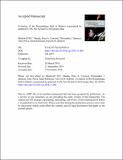Files in this item
Evolution of the Mozambique Belt in Malawi constrained by granitoid U-Pb, Sm-Nd and Lu-Hf isotopic data
Item metadata
| dc.contributor.author | Manda, Blackwell W.C. | |
| dc.contributor.author | Cawood, Peter A. | |
| dc.contributor.author | Spencer, Christopher J. | |
| dc.contributor.author | Prave, Tony | |
| dc.contributor.author | Robinson, Ruth | |
| dc.contributor.author | Roberts, Nick M.W. | |
| dc.date.accessioned | 2019-11-29T00:37:14Z | |
| dc.date.available | 2019-11-29T00:37:14Z | |
| dc.date.issued | 2018-11-29 | |
| dc.identifier | 257287855 | |
| dc.identifier | bf20fead-fede-4b9d-ad3d-50761bdaceda | |
| dc.identifier | 85059479389 | |
| dc.identifier | 000468247200007 | |
| dc.identifier.citation | Manda , B W C , Cawood , P A , Spencer , C J , Prave , T , Robinson , R & Roberts , N M W 2018 , ' Evolution of the Mozambique Belt in Malawi constrained by granitoid U-Pb, Sm-Nd and Lu-Hf isotopic data ' , Gondwana Research , vol. In press . https://doi.org/10.1016/j.gr.2018.11.004 | en |
| dc.identifier.issn | 1342-937X | |
| dc.identifier.other | RIS: urn:682D60429CEF3D391DC153280EE1C59A | |
| dc.identifier.other | ORCID: /0000-0002-4614-3774/work/64033689 | |
| dc.identifier.uri | https://hdl.handle.net/10023/19025 | |
| dc.description | First author would like to thank the University of Malawi (Chancellor College) and the University of St Andrews for sponsorship to study for a PhD through which the field research data was generated. U-Pb zircon geochronology and Nd isotope analyses at (NIGL) were supported by NERC grant NIGF-IP-1453-0514 to Cawood and Manda. Peter Cawood acknowledges support from Australian Research Council grant FL160100168. | en |
| dc.description.abstract | U-Pb, Sm-Nd and Lu-Hf isotopic data for granitoid rocks from southern Malawi provide constraints on the timing and sources of magmatic activity within this segment of the Mozambique Belt and its role in the Rodinia and Gondwana supercontinent cycles. LA-ICP-MS single zircon U-Pb ages indicate a number of periods of magmatic activity: late Mesoproterozoic at ca. 1130 Ma, 1070 Ma, and 1050 to 1030 Ma; Neoproterozoic at ca. 960 Ma and 600 Ma; Cambrian at ca. 530 and 515 Ma, and Mesozoic at ca. 120 Ma. The oldest igneous activity, 1128 ± 30 Ma, corresponds with emplacement of a charnockitic granitoid in the southeast corner of Malawi (Mulanje area). This region subsequently experienced metamorphism dated at 515 ± 18 Ma. The youngest magmatism is alkaline in affinity and is associated with the East African Rift. Radiogenic isotope data indicate that the Mesoproterozoic samples have positive ɛNd and ɛHf values, signifying derivation from material with a suprachondritic signature, whereas the younger rocks have negative values suggestive of crustal material recycling and mixing for their source and origins. The data imply that in the Malawi region of the Mozambique Belt, addition of new crust occurred during Rodinia assembly whereas magmatic activity during Gondwana assembly was restricted to reworking and mixing. | |
| dc.format.extent | 16317489 | |
| dc.language.iso | eng | |
| dc.relation.ispartof | Gondwana Research | en |
| dc.subject | Mozambique Belt | en |
| dc.subject | Gondwana | en |
| dc.subject | Malawi | en |
| dc.subject | Metamorphism | en |
| dc.subject | Depleted mantle | en |
| dc.subject | GE Environmental Sciences | en |
| dc.subject | DAS | en |
| dc.subject.lcc | GE | en |
| dc.title | Evolution of the Mozambique Belt in Malawi constrained by granitoid U-Pb, Sm-Nd and Lu-Hf isotopic data | en |
| dc.type | Journal article | en |
| dc.contributor.institution | University of St Andrews. School of Earth & Environmental Sciences | en |
| dc.contributor.institution | University of St Andrews. Marine Alliance for Science & Technology Scotland | en |
| dc.contributor.institution | University of St Andrews. Scottish Oceans Institute | en |
| dc.contributor.institution | University of St Andrews. St Andrews Sustainability Institute | en |
| dc.contributor.institution | University of St Andrews. St Andrews Isotope Geochemistry | en |
| dc.identifier.doi | https://doi.org/10.1016/j.gr.2018.11.004 | |
| dc.description.status | Peer reviewed | en |
| dc.date.embargoedUntil | 2019-11-29 |
This item appears in the following Collection(s)
Items in the St Andrews Research Repository are protected by copyright, with all rights reserved, unless otherwise indicated.

